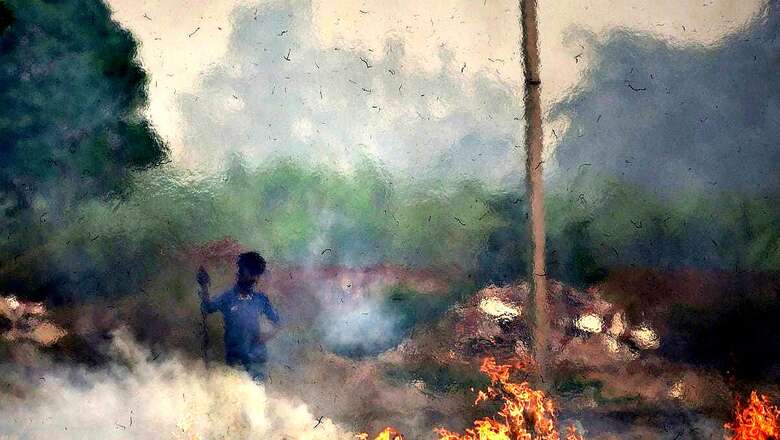
views
The air quality over the national capital has started deteriorating with hazy skies signalling the arrival of the deadly winter pollution. The average Air Quality Index (AQI) in Delhi touched 234 (poor) on Monday, and surged to 271 in Ghaziabad and 268 in Noida, as per the Central Pollution Control Board (CPCB).
The Commission for Air Quality Management (CAQM) enforced a 27-point emergency response action plan under GRAP-1 in Delhi-NCR from Tuesday, urging residents to take precautions. The abrupt rise in stubble burning incidences after October 10 has raised worries, with the surface winds predominantly now blowing from the north-west.
Over 484 residue-burning incidents have been detected by satellites over the last two days — 244 from Punjab, 119 from Haryana and 101 from Uttar Pradesh. Despite massive campaigns to dissuade farmers from setting the paddy residue on fire, as many as 2,015 fire counts have been detected from September 15 to October 14. Majority of the incidents were from Punjab (940), followed by Haryana (497), Uttar Pradesh (423), Madhya Pradesh (85), Rajasthan (63) and Delhi (07).
“Stubble burning is a grave concern. The Commission for Air Quality and Management (CAQM) has already authorised the Deputy Commissioners/ District Collectors/ District Magistrates in the neighbouring states to prosecute officials in case of inaction in controlling stubble burning in their jurisdiction,” said Leena Nandan, Secretary of the Ministry of Environment, Forest and Climate Change (MoEFCC) on Monday.
The orders could lead to action against nodal officers, supervisory officers at various levels, as well as station house officers who fail to prevent paddy stubble burning in their respective jurisdiction. The CAQM has also sent out 26 central teams to the hotspot districts in Punjab and Haryana where the incidents are generally higher.
The hotspot districts include 16 districts from Punjab, including Amritsar, Tarn Taran, Bathinda, Sangrur, and 10 from Haryana, including Ambala, Kurukshetra, Karnal and Jind. A ‘Paddy Stubble Management Cell’ has also been set up at Chandigarh for coordinating the action on the field.
Every year, farmers set fire to million tonnes of paddy straw to clear their fields after reaping Kharif crops. The delayed withdrawal of the monsoon adds to the challenge, leaving a small harvesting window for the farmers who race against time to sow the next crop. This year too, the monsoon rains continued across Northwest India till the end of September, and witnessed a delayed retreat by October 3.
An estimated 19.52 million tonnes of paddy stubble is likely to be generated in Punjab and 8.10 million tonnes in Haryana this harvesting season. While Aam Aadmi Party (AAP)-led Punjab has committed to managing about 11.52 million tonnes of it through in-situ crop management, the BJP-led Haryana has plans for managing about 3.3 million tonnes in-situ — the rest through ex-situ management.
Both the states have about 2.4 lakh crop residue management (CRM) machines, with 1.5 lakh of them in Punjab, supported by 24,736 custom hiring centres, according to government figures. In addition, two million tonnes of paddy straw will be co-fired in 11 thermal power plants across the NCR region, according to CAQM.
The latest forecast from the IMD-Indian Institute of Tropical Meteorology (IITM) suggests the air quality is likely to remain in the poor category this week, though it may improve briefly due to the changing wind direction.




















Comments
0 comment